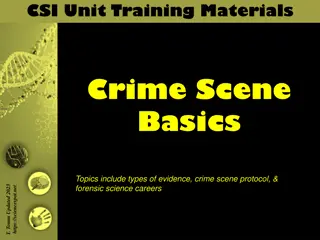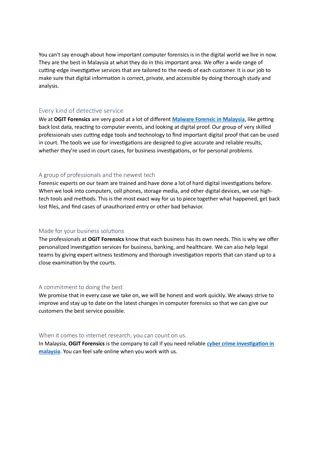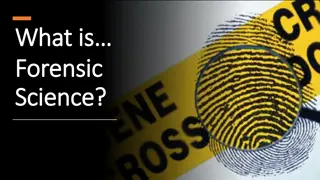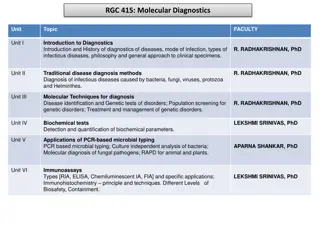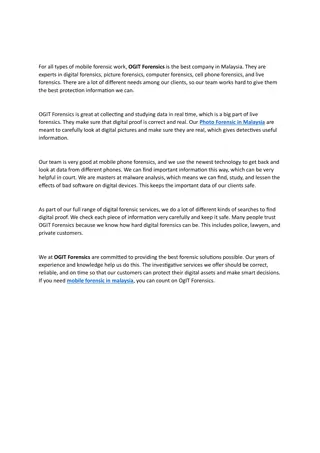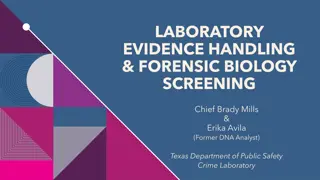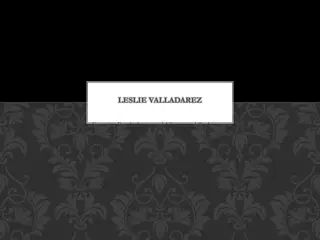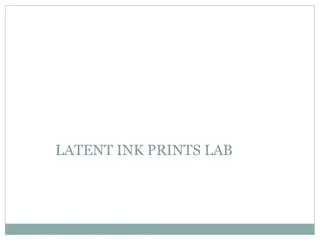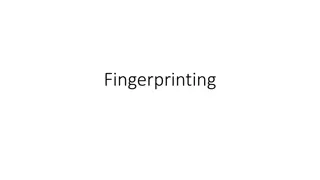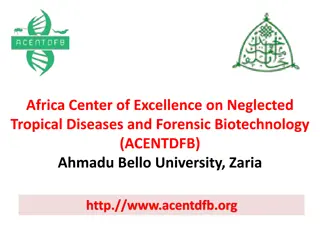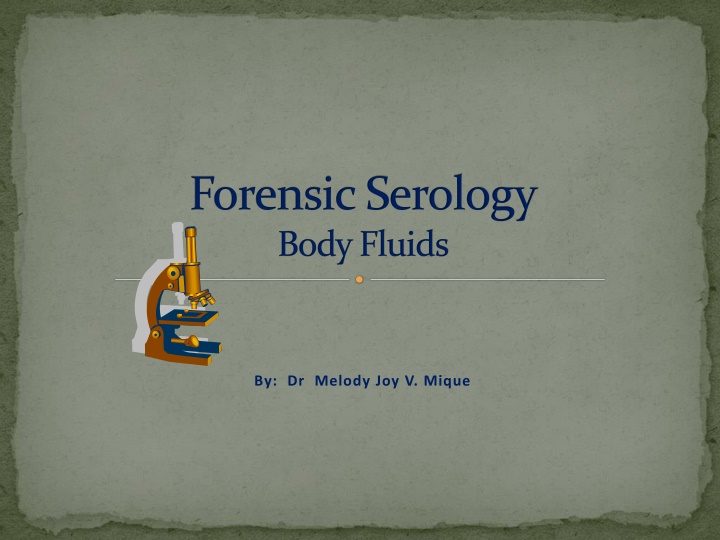
Forensic Serology and Body Fluids Examination
"Discover the history and significance of forensic serology, the science of analyzing body fluids for evidence in legal investigations. Learn about techniques, types of physiological fluids, and the characteristics of blood."
Download Presentation

Please find below an Image/Link to download the presentation.
The content on the website is provided AS IS for your information and personal use only. It may not be sold, licensed, or shared on other websites without obtaining consent from the author. If you encounter any issues during the download, it is possible that the publisher has removed the file from their server.
You are allowed to download the files provided on this website for personal or commercial use, subject to the condition that they are used lawfully. All files are the property of their respective owners.
The content on the website is provided AS IS for your information and personal use only. It may not be sold, licensed, or shared on other websites without obtaining consent from the author.
E N D
Presentation Transcript
Forensic Serology Body Fluids By: Dr Melody Joy V. Mique
Forensic Serology Forensic Serology The science that deals with the properties, characteristics and reactions of body fluids in laboratory testing. Relating to the use of science or technology in the investigation and establishment of facts or evidence in a court of law
Pertains to the use of science or technology in the investigation 0f the properties, characteristics and reactions of body fluids in laboratory testing for the establishment of facts or evidence in a court of law.
History of Forensic Serology 1800s working on the development of techniques to establish if a stain was in fact a blood of human origin or not Mid-1800 Gregor Mendel= genes ; heredity 1868= Van Deen; Guaiacum test 1900s Early 1900 Phenolphthalein test; (1901)Kaste and Sheed Phenolphthalein test= presumptive color change test distinguish human from animal blood > Precipitin Test; Uhlenhuth > Different Blood Groups Karl Landsteiner
Mid 1900s 1980s 1916; a technique for the ABO grouping of dried blood stain was developed(Leone Lattes) 1985; DNA Finger printing ( Alec Jeffreys) > Thus the word DNA profiling and DNA Typing became a term 1937; chemical luminal was developed (Walter Specht) Chemical luminal that would glow in the dark when sprayed in a blood stain
Types of Physiological BodyFluids 5. Feces 6. Vomitus 7. Perspiration 8. Tears 1. Blood 2. Semen and Vaginal Secretion 3.Saliva 4. Urine
Characteristics of the Blood 1. Red in color (Hemoglobin) 2. Invivo :Fluid in form due to anticoagulants Invitro = it coagulates 5-10 minutes 3.It is thick and viscous (3.5-4.5 times thicker than water) 4. It makes up 7-8% of the total body component (75-85 ml blood per kilogram body weight) Blood Most common evidence found in crime scenes Red Fluid circulated by the heart and flows in the veins, arteries and capillaries to transport oxygen, nutrients and wastes.
Functions of the Blood 1.transportation 2.Regulation of body temperature a. Nutritional (nutrients Maintenance of homeostasis (ions minerals, water etc) 3. Protection a. Blood Coagulation/ Blood Clotting and hormonal secretions) absorption happens in the Small intestine and large intestine b. Respiratory = Oxygen to the brain c. Excretory = carries waste to wards the kidney Immunologic/Body defense mechanism
Methods of Blood Collection SKIN PUNCTURE Done when small quantity of blood is needed such as in blood typing and CBC. It is obtained from the skin VENIPUNCTURE Done when large quantities of blood is needed; when blood needs to be tested with several blood analysis. It is obtained from the veins.
Methods of Blood Collection Cont SKIN PUNCTURE * Blood Obtained is called: 1. Capillary Blood 2. Peripheral Blood Materials used: Lancet Needles Blade Cotton ( wet/dry) Alcohol Collecting Materials: Capillary tubes Glass slide Pipettes 3. Arteriolar Blood * Sites of Puncture: 1.Margin of the earlobe 2. Palmar surface of the finger 3.Plantar surface of the heel and toe
Methods of Blood Collection Cont Things to be noted during Skin Puncture: 1. Puncture should be 2.5-3mm deep (capillary bed) 2.Pressure and squeezing should be avoided ( Prevent admixture of Blood w/ tissue juices 3.First drop of blood should be discarded ( Tissue juices & dead epidermal cell)
Methods of Blood Collection Cont VENIPUNCTURE *Three Factors Needed: 1. Venipuncturist (Phlebotomist) 2. Patient and his Veins 3. Equipments: a. Syringe or vacutainer tube * Needles should be chosen for specific task b. tourniquet c. Cotton d. 70% alcohol e. Collecting Materials such as tubes vial bottles
Methods of Blood Collection Cont VENIPUNCTURE Advantages: 1. Larger amount of blood is obtained for variety of tests 2. Additional and repeated test can be done 3. Blood collected can be transported in the Laboratory for future use 4. Blood collected is ideal for Chemistry analysis
Methods of Blood Collection Cont 3.The tourniquet should be released first before removing the needle from the vein 4. Containers are stoppered and those with anticoagulant be inverted several times 5. Needles should be properly disposed Things to consider during Venipuncture: 1.All materials should be dry and sterile 2.Torniquete should be applied at list three inches above the site of puncture and it should not be too tight
UP next is Fun Learning
SELF ASSESSMENT 1.Why should the tourniquet be released first before removing the needle from the vein? 2. Differentiate the 2 types of blood collection(skin puncture and Venipuncture) and give advantages of each. 3. Explain the three functions of the blood( Transportation, Balance, Protection)
Blood Jan Swammerdam = young Dutch biologist ,the first person to describe red blood cells who had used an early microscope in 1658 to study the blood of a frog. Unaware of this work Anton van Leeuwenhoek provided another microscopic description in 1674, this time providing a more precise description of red blood cells, even approximating their size, "25,000 times smaller than a fine grain of sand".
Karl Landsteiner published his discovery of the three main blood groups A, B, and C (which he later renamed to O). Landsteiner described the regular patterns in which reactions occurred when serum was mixed with red blood cells, thus identifying compatible and conflicting combinations between these blood groups. Alfred von Decastello and Adriano Sturl = two colleagues of Landsteiner, identified a fourth blood group AB.
Dr. Max Perutz = In 1959, by use of X-ray crystallography, he was able to unravel the structure of hemoglobin, the red blood cell protein that carries oxygen. The only known vertebrates without erythrocytes are the crocodile icefishes
Blood Composition 1. Formed Elements a. Red Blood Cells (RBC)/ erythrocytes/ erythroplastids erythrocytes (from Greek erythros for "red" and kytos for "hollow", with cyte translated as "cell" in modern usage). b. White Blood Cells (WBC), Leucocytes, Leucoplastids leuko-meaning "white Plastids= molder, storage 2. Liquid Portion A. Serum B. Plasma
Formed Elements 1. Red Blood Cells (RBC)/ erythrocytes/ erythroplastids = rich in Hemoglobin, an iron-containing biomolecule that can bind oxygen. main component of RBC = Respiratory pigment/ red coloring; =When erythrocytes undergo shear stress in constricted vessels, they release ATP which causes the vessel walls to relax and dilate so as to promote normal blood flow. =The functional lifetime of an erythrocyte is about 100 120 days
Types of Hemoglobin (Hgb) 1. Normal Hgb a. OxyHgb = Bright red Oxygenated Blood b. DeoxyHgb= Dark red Deoxygenated Blood / 2. Abnormal Hgb/Non Functional a. CarboxyHgb= cherry red/ Hypoxia b. SulfHgb = lavender c. MetHgb= chocolate brown
MetHgb= metalloprotein hemoglobin, in which the iron in the hemegroup is in the Fe3+(ferric) state, not the Fe2+(ferrous) of normal hemoglobin. Methemoglobin cannot bind oxygen Can cause health problems known as methemoglobinemia. blue skin from an excess of methemoglobin. Methemoglobin saturation is expressed as the percentage of hemoglobin in the methemoglobin state; That is MetHb as a proportion of Hb.
Effect of Methemoglobin in the Body 1-2% Normal Less than 10% metHb - No symptoms 10-20% metHb - Skin discoloration only (most notably on mucus membranes) 20-30% metHb - Anxiety, headache, dyspneaon exertion 30-50% metHb - Fatigue, confusion, dizziness, tachypnea, palpitations 50-70% metHb - Coma, seizures, arrhythmias, acidosis Greater than 70% metHb - Death SulfHgb Cause=cyanosis
2. White Blood Cells (WBC), Leucocytes, Leucoplastids= are cells of the immune system, involved in defending the body against both infectious diseases and foreign materials =The number of leukocytes in the blood is often an indicator of disease =normally approximately 7000 white blood cells per micro liter of blood. They make up approximately 1% of the total blood volume in a healthy adult. Leukocytosis= Increase in the number of leukocyte Leucopenia= decrease in the number of leukocyte Leukemia= the presence of malignant leukocyte
LEUKOCYTOSIS is experienced when there is an 1. Allergic reactions. These could be severe allergies 2. Measles, 3. Certain kinds of leukemia, 4. Have taken in certain drugs like epinephrine and corticosteroids, 5. Smoking 6. Tuberculosis and Whooping cough 7. Stress 8. Tissue damage 9. Bacterial infections 10. Viral infections
Five Types of Leukocyte Basophils Neutrophils Lymphocytes Eosynophils Monocytes
Neutrophil = against bacteria and fungi infection, their death forms pus; life span 5.4 days Eosynophils= deal with parasitic infections, predominant inflammatory cells in allergic reactions such as asthma, hay fever, and hives Basophils= allergic and antigen response by releasing the chemical histamine causing vasodilation Lymphocytes ( B cells= make antibodies that bind to pathogen to enable their destruction. T cells=, Natural killer cells) Monocyte= shares with the "vacuum cleaner" (phagocytosis) function of Neutrophils, but are much longer lived as they have an additional role: they present pieces of pathogen to T cells so that the pathogens may be recognized again and killed, or so that an antibody response may be mounted.
Liquid Portion A. Serum Liquid Portion of Clotted Blood, w/o the protein fibrinogen B. Plasma Liquid Portion of un clotted blood with the protein fibrinogen
Liquid Portion A. Serum = does not contain white or red blood cells It contains Proteins, electrolytes, antibodies, antigen, hormones and exogenous substances. B. Plasma Liquid Portion of un clotted blood with the protein fibrinogen ( can be obtained through centrifugation) = Contains WBC and platelets
Platelets Responsible in the patching of a wound Platelets do not have a uniform shape. Rather, they are reminiscent of an amoeba, being blob-like, with long and thin surface projections. Platelets are recruited to the site of a cut or wound. Their shape and sticky surface facilitates their clumping together, along with calcium, vitamin K, and a protein called fibrinogen. The clump is known as a clot.
Plasma= straw-colored liquid The various blood cells are suspended in it. Plasma is composed mainly of water. Physiologically-important ions including calcium, sodium, potassium and magnesium comprise plasma. Plasma provides the medium in which the blood cells are suspended and transported around the body. As well, the disease-fighting antibodies produced by the immune system are also ferried to where they are needed via the plasma.
Fun Learning
SELF ASSESSMENT 1. Differentiate Serum from plasma 2. Differentiate the 2 kinds of normal hemoglobin( oxyHgb and DeoxyHgb) 3. What is the indication of an increased number of WBC in the microscopic examination of blood
SELF ASSESSMENT 1. Identify the 5 types of leucocytes and explain its role of protecting our body from harm 2. Differentiate Serum from plasma 3. Differentiate the 2 kinds of normal hemoglobin( oxyHgb and DeoxyHgb) 4. What is the indication of an increased number of WBC in the microscopic examination of blood 5. Differentiate leucopenia from Leukocytosis



